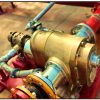The Need to Conduct Periodic Tests of Foaming Systems of Hydrocarbon Storage Tanks
The need to conduct periodic tests of foaming systems of hydrocarbon storage tanks : The audit and evaluation of tank foaming systems is of great importance to show the real safety situation and possible risks for fire extinguishing of tanks during a fire.
**

**
Foam systems must be inspected annually by foam experts in accordance with NFPA 11:2021 EN13565-2-2018, NFPA 25:2020 standards to ensure their correct performance. Before referring to the standard clauses about this necessity, we will briefly examine the causes of tank fires.
**

**
Factors causing tank fires – US statistical population
(A study of storage tank accidents, Journal of Loss Prevention in the Process Industries 19 (2006) 51-59)
There are many reasons such as equalizing the quality of the product, measuring the volume of the product for sale, the possibility of loading and transferring it to the tanker or ship in the least possible time, etc., which causes the raw materials or the product to be stored in suitable tanks after production. The term tank is used for large storage containers with the application of moving, storing, measuring and transporting liquids. Tanks are used for various purposes in production and refining processes, and their safety is always a concern for organizations.
The factors that cause tank fires have been obtained in a research as described in the figure below by specifying the percentage according to the statistical population.
These factors are as follows:
1. Lightning: 33%
2. Supply and maintenance: 13%
3. Operational error: 12%
4. Equipment failure: 8%
5. Failure: 8%
6. Cracks: 7%
7. Leaks and cracks in the pipeline: 6%
8. Static electricity: 5%
9. Open fire: 3%
10. Natural events: 3%
As this research states, the most important causes of tank fires are lightning, human errors, and equipment malfunctions.
**
Requirement of standards to conduct audit of fire extinguishing equipment of tanks
Following Notes are based on EN13565:2 for inspection of foam systems:
**
“11.3 The periodic inspection and testing of foam systems
11.3.1 General
Regular checks and maintenance are necessary to keep the operational readiness of foam extinguishing systems. The user shall nominate a responsible person and a deputy taking care for the execution of the operation and maintenance instructions given by the installer and the legal regulations and the following inspections. Necessary repair-work shall be arranged. All applied measures as well as events shall be recorded in a log book.
**
11.3.2 Inspections
11.3.2.1 Weekly inspections (by user/ trained personnel)
11.3.2.2 Monthly inspection (by user/ trained personnel)
11.3.2.3 Half-yearly inspection
functionally test the foam concentrate proportioner using water without the use of foam concentrate (where specified by the manufacturer); test the free movement of all valves and mechanically operated components.
11.3.2.4 Yearly inspections (foam system specialists)
11.3.2.4.1 Foam concentrate quality;
11.3.2.4.2 Foam proportioning accuracy test
A test of the proportioner and associated fittings shall be carried out. The test shall be carried out at the maximum and minimum system design flow rates. The accuracy of foam proportioning shall be in accordance with the tolerance given in pr EN 13565-1.
**

**
Annual test of fitness equipment
As it is clearly mentioned in the standard clauses, the annual test of fitters should be done practically by experts in the field of foam, and the accuracy of fitters should be verified within the acceptable range of the standard.
NFPA, this interval is in the 2021:11 standard and for the nominal mixing ratio of 3% according to the diagram below. This means that the mixing ratio can change from 3 to 3.9 percent.
**

**
Procedures for annual audit of fixed fire extinguishing systems of tanks
Conducting an audit includes the following steps:
1. Choosing the right standard and extracting relevant items suitable for each site
2. Checking the technical documents and calculations and their compliance with relevant references and standards separately for each site
3. Visual inspection of equipment, components and parts and their compliance with technical documents and relevant standards
4. Practical test, including and not limited to measuring time/flow/pressure/sampling, etc. and checking compliance with technical documents and standards
5. Providing reports including review and control of technical documents, visual inspection report, practical test report and laboratory results report.
6. Examining problems/non-conformities/deviation from Gap analysis standard
**

**
**




